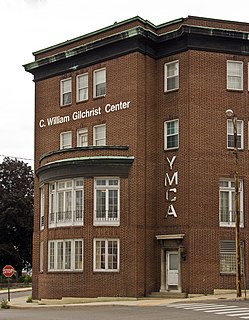
The Cumberland YMCA building is a three-story wedge-shaped brick structure with a partially raised basement, built in 1925 in the Classical Revival style, located in Cumberland, Maryland, United States. It is an excellent example of institutional architecture of its time. At the time of its construction, it offered the only indoor swimming pool in the area.

St. Paul's Episcopal Church is a parish of the Episcopal Church near Point of Rocks, Frederick County, Maryland, in the Episcopal Diocese of Maryland. It is noted for its historic parish church, a small late Federal style brick structure built in 1842.

The Shaw Mansion is an Italianate style house in the George's Creek Valley of Allegany County, Maryland, built in 1872. The house is significant as an unusually large and well-preserved example of the style for its area, with stone trim, detailed brick bonding, cast-iron mantels and much of the original interior woodwork.

The African Methodist Episcopal Church in Cumberland, Allegany County, Maryland, was built in 1892 to replace a previous church which the congregation had outgrown. The congregation was founded in 1847 by a group of African-American Methodists who had previously worshiped from the balcony of the Centre Street Methodist Episcopal Church. The first church was built in 1848, then rebuilt and enlarged in 1871 and again in 1875.
Big Bottom Farm is a farm in Allegany County, Maryland, USA on the National Register of Historic Places. The Greek Revival house was built circa 1845, possibly by John Jacob Smouse, and exhibits a level of historically accurate detailing unusual for the area. The property includes a late 19th-century barn and several frame outbuildings.

George Truog House is a historic home in Cumberland, Allegany County, Maryland, United States. It is a 3-story brick structure built in 1903. The house was designed by local architect Wright Butler, and built by George Truog, proprietor of the Maryland Glass Etching Works in Cumberland from 1893 to 1911. It contains a unique collection of decorative glass.

Town Clock Church is a historic church in Cumberland, Allegany County, Maryland, United States. It is a one-story gable-front brick building built in 1848 by its German Lutheran congregation. A tall clock tower rises from the slate roof above the principal facade.

The Canada Hose Company Building is a historic firehouse in Cumberland, Allegany County, Maryland, United States. It is a two-story gable-front brick structure. Above the doors used for the fire engines is a sign which reads "Cumberland Hose Co. No. 1." The building is the oldest of a number of old firehouses built in Cumberland during the 19th century; it was completed in 1845.
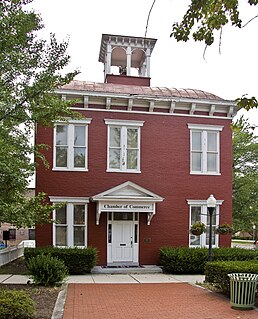
Bell Tower Building, or the Allegany County League for Crippled Children building, is a historic building in Cumberland, Allegany County, Maryland. It was built in 1887 and is a two-story brick structure topped by a small wooden tower with an open belfry. This was the first separate building to be used as police headquarters and jail in Cumberland.
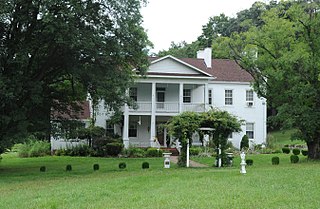
Phoenix Mill Farm, historically known as Mill Run Farm, is a historic home located in Dickens, Allegany County, Maryland, United States. It is a 2+1⁄2-story Flemish bond brick structure showing Greek Revival style influences built about 1845. It has a gable roof and double flush chimneys. On the property is the site of Smouse Mill. The home was erected for John Jacob Smouse, who operated the mill.
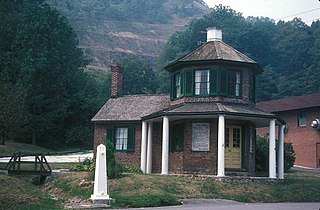
La Vale Tollgate House is a historic toll house in La Vale, Allegany County, Maryland, United States. It is a two-story brick structure built in 1835–1836, with seven sides—a basic polygon plan. A one-story Tuscan-columned porch extends around the five outer sides of the polygonal portion. On top is a non-functional reconstructed cupola. The building served as a toll house on the Cumberland or National Road and was the first such structure to be erected.
The Frostburg Historic District is a national historic district in Frostburg, Allegany County, Maryland. It comprises 356 resources within the city of Frostburg, along U.S. Route 40, which forms the main axis of the district. Included are a collection of early-20th century commercial buildings, primarily of brick construction, two or three stories tall, and a collection of mid- to late-19th and early-20th century homes reflecting a variety of architectural styles, including Italianate, Second Empire, Queen Anne, and Colonial Revival.

The Greene Street Historic District is a national historic district in Cumberland, Allegany County, Maryland. It is a 7-acre (28,000 m2) linear historic district along both sides of Greene Street on the west side of Cumberland. It contains 45 buildings, 37 of which are residential and 8 of which exhibit commercial design characteristics. The earliest buildings in the district are built in the Federal style, followed by buildings erected in the Greek Revival, Italianate, Queen Anne, and Colonial Revival styles. The earliest of the district's resources was constructed about 1820, with the most recent built about 1930.

The Lonaconing Historic District is a national historic district in Lonaconing, Allegany County, Maryland. It comprises 278 buildings and structures consisting of a variety of 19th and early-20th century commercial, industrial, and residential buildings. These structures identify with the development of Lonaconing as a center of the iron, coal, and silk industries in the George's Creek Valley of Western Maryland. It includes a group of 40 late-19th and early-20th century brick or frame commercial structures, including a hotel, bank, three dry goods stores, and numerous other shops and warehouses, mostly constructed after a fire which devastated downtown in 1881.
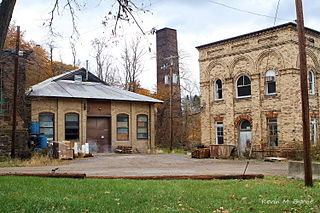
The Mount Savage Historic District is a national historic district in Mount Savage, Allegany County, Maryland. It comprises 189 19th and 20th century buildings, structures, and sites within this industrial community northwest of Cumberland. The structures reflect the community's development as a center of the iron, coal, brick, and railroad industries from the 1830s to the early 20th century. Included are a set of vertical-board duplexes on Old Row built about 1840, and possibly the earliest examples of workers' housing remaining in the region.

The Inns on the National Road is a national historic district near Cumberland, Allegany County, Maryland. It originally consisted of 11 Maryland inns on the National Road and located in Allegany and Garrett counties. Those that remain stand as the physical remains of the almost-legendary hospitality offered on this well-traveled route to the west.

Mt. Pleasant, also known as the Clemson Family Farm, is a historic home located at Union Bridge, Carroll County, Maryland, United States. It is a five-bay by two-bay, 2+1⁄2-story brick structure with a gable roof and built about 1815. Also on the property is a brick wash house, a hewn mortised-and-tenoned-and-pegged timber-braced frame wagon shed flanked by corn cribs, and various other sheds and outbuildings. It was the home farm of the Farquhar family, prominent Quakers of Scotch-Irish descent who were primarily responsible for the establishment of the Pipe Creek Settlement.

St. Luke's Church is a historic Episcopal church located at Church Hill, Queen Anne's County, Maryland. It was built between 1729 and 1732 as the parish church for St. Luke's Parish, which had been established in 1728.

Johnsville is an unincorporated community in Frederick County, Maryland, United States. It is located approximately halfway between Libertytown and Union Bridge along Maryland Route 75. The Kitterman-Buckey Farm was listed on the National Register of Historic Places in 2005.

Rolling Mill Historic District is a national historic district located at Cumberland, Allegany County, Maryland. It is a 38-acre (15 ha) primarily residential historic district located on the east side of the city of Cumberland. It contains a strong, locally distinctive concentration of wood and brick residences built between the early 1870s and the late 1940s. It also includes a modest commercial area. The district has a total of 173 properties, including the previously listed Francis Haley House.






















